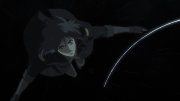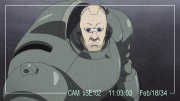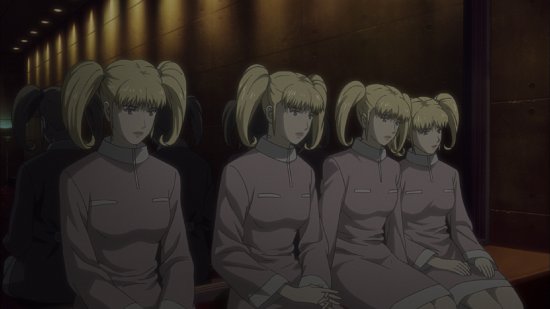Review for Ghost in the Shell: Stand Alone Complex - Solid State Society
Introduction
Five years after its UK DVD release, Ghost in the Shell: Stand Alone Complex: Solid State Society is back for its Blu-ray debut. Actually it's the first in a pair of very timely Blu-ray upgrades from Manga Entertainment. This month it's Solid State Society, and next month we finally get the UK home digital release of Katsuhiro Otomo's Roujin Z. Both movies take a look at a future Japan suffering from the sociological effects of a geriatric time bomb. Solid State Society's take on it is classic cyberpunk as you would expect from the Ghost in the Shell franchise, but Roujin Z's take on it infuses a whole lot of satire into its cyberpunk musings. I say all this is timely, as quite recently, Japan's demographic downward spiral has once again been in the news. The old are beginning to outnumber the young, the birth-rate is too low to maintain the population, and the young just aren't interested in procreation any more. It's a topic that is covered in the news on a regular basis these days, as the crisis gradually gets more and more prominent, and just recently, someone did the maths and plotted the statistics, extrapolating the direst consequences for Japan. It turns out that in 1000 years, the Japanese people will be extinct due to the decline in birth rates. With no one left to take care of the old, the likelihood that the grey population will have to be plugged into some sort of automatic care device seems less and less like a fiction, and more and more like a realistic prospect.
Masamune Shirow's Ghost in the Shell manga has spawned one of the most memorable anime franchises around. Mamoru Oshii's Ghost in the Shell movie kicked things off in explosive philosophical style, and it also spawned the Ghost in the Shell 2: Innocence sequel. That original film has seen a Lucasing, with the feature upgraded for the high definition age and re-released as Ghost in the Shell 2.0. The Stand Alone Complex series has the same characters and world, but tells an alternate story. Kenji Kamiyama created a more action oriented, procedural sci-fi series, one which has drawn many fans to the anime medium, and holds up astonishingly well even now, as one of the best television anime ever made. There were two series in all, Ghost in the Shell: Stand Alone Complex, and Ghost in the Shell: Stand Alone Complex 2nd Gig. But as you can imagine, there are a lot of stories that can be told in this universe and with these characters. Kenji Kamiyama would then return to Stand Alone Complex with a theatrical feature, Solid State Society, which in effect acts as a 3rd Gig, distilling the essence of the Complex elements of a series run, and dispensing with the Stand Alone episodes. Subsequently, this process was applied retroactively to the two television series to create the Laughing Man and Individual Eleven features. Most recently, this Solid State Society movie has been re-released to Japanese theatres converted to 3D (an absurd idea given that anime is mostly a 2D medium). Ghost in the Shell just won't die. Thankfully this Blu-ray release is the same 2D Solid State Society movie that was released a few years ago in the US. The 3D version has yet to see a home video release anywhere. As I've already reviewed the film on DVD, anything in italics is a cut and paste from my original review.
Ghost in the Shell: Stand Alone Complex is set in a world where the lines between man and machines have blurred into insignificance. When people can have their brains cyberized, and technologically augmented so that they can connect to the net at will, where they can swap bodies as easily as changing clothes, the boundaries between life and machines, man, robot and cyborg become meaningless. It's also a world where cybercrime is a major problem, where unsuspecting individuals can be hacked and reprogrammed to become unwitting perpetrators of crime. In this world, you need a special sort of police force, which is where Section 9 comes in, tasked with investigating the unlikeliest of crimes and preventing terrorism in the strangest of new worlds.
Following the conclusion of the Individual Eleven crisis, Major Motoko Kusanagi left Section 9 to go into business as a freelance investigator. Togusa was promoted to lead the group in her stead, and their numbers began to swell as Aramaki became determined to secure his legacy. Following the Major's departure, Batou remains out of sorts, choosing his own assignments according to instinct rather than working with the team. But it's one of Batou's hunches that lead the team to investigate a terrorist attack planned on the Japanese mainland. But before they can be stopped, the terrorists kill themselves in a wave of suicides, warning in their dying breaths that the Puppeteer is coming. The Puppeteer is apparently a hacker so powerful that he can convince his victims to kill themselves. The terrorist plan had been to use abducted children to deliver a lethal virus, but they were only taking advantage of a larger plan. A large number of children are being abducted and cyberized, their parents' memories rewritten to forget they even had children. The country's geriatric population, plugged into a network of automated nursing machines is somehow involved, and when Batou tries to investigate, he runs into the Major, who warns him to stay away from the Solid State Society, lest he becomes a victim of suicide. Could the Major be the Puppeteer?
Ghost in the Shell: Stand Alone Complex: Solid State Society is released on Blu-ray as a Dual Play collection, with the DVD version of the film included. I'm reviewing only the Blu-ray component of the collection here.
Picture
Solid State Society gets a 1.78:1 widescreen 1080p transfer on this Blu-ray. I get the feeling that the feature originally wasn't animated at 1080 lines of resolution, as this isn't the massive upgrade in quality that you'd expect of your usual Blu-ray. It lacks the pin sharp resolution and fine detail of a full HD presentation. That said, it is a major improvement on the DVD in every other respect. There is now absolutely no digital banding, no compression artefacts, and no aliasing. It looks like a film presentation of an animation. Also, detail levels are higher, colours are stronger and more vivid, and the richness of the textures and surfaces in background scenes is much more evident. Little things struck me about this transfer, such as the stark visual impact of the opening scene in the airport, in the Ka Gael stand-off, when Togusa comes up against the laser barrier. I was also taken with the detail in a couple of teddy bears in the background of Togusa's apartment. There are some moments of fast animation which aren't quite smooth, especially in some pans. I had a quick look at my PAL converted DVD version from five years ago, and the same issue is evident there, so it may be a problem with the source material and not the transfer.
The images in this review are sourced from the PR, and aren't necessarily representative of the final retail release.
Sound
That DVD certainly packed a wallop when it came to audio, with the then usual Manga trinity of DD Stereo, 5.1 and DTS in both English and Japanese. That DTS track still wins in terms of sheer loudness, but in reality comparing it to the Dolby TrueHD 5.1 English and Japanese on this Blu-ray is a waste of time. Lossless audio really shows its superiority here, with audio that is vibrant, dynamic, subtle when required, and bombastic during the action sequences. Again I was noticing the little things, such as the hum of an electrical generator in a parking garage, which gets muted when the protagonists get inside a car to chat. The facility with which the soundstage is used to convey the action and atmosphere of the movie puts that DVD to shame, and it's here that the upgrade really becomes obvious. It doesn't hurt that Yoko Kanno's music in True HD format is to die for. I went with the original language track as always, but Ghost in the Shell's English dub is just as good. Unlike the DVD, you now get translated subtitles and a separate signs only track to accompany the English dub. Also unlike that original DVD, the errors in that subtitle track are now gone, and the missing and incorrect words are a thing of the past. That's except for one missing letter in a subtitle caption at 49:54 into the movie.
Extras
That first DVD release was a 2-disc release, with the extras on a second disc. This Blu-ray Dual Play is also a 2-disc release, with the feature and the extras on the Blu-ray disc, while the DVD disc holds the theatrical feature alone. If it is the same disc as before, it should also have a Storyboard Subtitle track, a rather poor offering that made me wish for the higher definition of a Blu-ray disc.
The irony of course is that this Blu-ray disc does not have the Storyboard Subtitle track. In fact, despite a few hints earlier this year about new extra features, the only extras on the Blu-ray have been taken from that second DVD disc. The Blu-ray has an animated menu screen with clips from the film running. It also appears to be the US disc complete with FBI warning, now coded for Region B.
Every episode of Stand Alone Complex ended with the Tachikomatic Days animation, featuring our little blue robotic friends. At the end of the 2nd Gig, the larger Uchikomas had replaced them, and hence we get an Uchikomatic Days animation to accompany the feature. It's longer than usual at 5 minutes.
Anime & Car Design: Designing The Future Car lasts 25 minutes, and the filmmakers and carmakers talk about the collaboration that came about as a result of this film. Togusa drives a Nissan sports concept in the film, and Section 9 has an SUV for the team. Both of these are real world designs that the car company created, and here we learn how the design of the cars, as well as realising them in animation became a two way collaborative process.
English Production Interview lasts 10 minutes, and the English language cast and crew offer some of their thoughts on the film and the franchise in general.
Making A Tachikoma Robot shows that you can't stop Japanese innovation. They actually built a real Tachikoma. Okay, so it's only a few inches high, and says some stock phrases, but over 17 minutes Tomotaka Takahashi describes how he turned animation into reality. I want one...
There is a 9-minute conversation with production IG founder, Mitsuhisa Ishikawa, and he talks about the history of Stand Alone Complex, as well as Solid State Society in particular.
Most significant on this disc is the World Work File, which effectively is a 31-minute long spoiler for the film. Naturally, do not watch this before the film itself. But as well as providing a story outline, this also comments on the GITS: SAC world, the characters and the technology, and there are little information nuggets along the way from the production team about how certain bits of animation were accomplished.
The English and Japanese trailers are also on here.
The Making of the Tachikoma Robot, Anime and Car Design, and Uchikomatic Days featurettes are presented in 1080i resolution. The other extras and the trailers are in 480i. In a change from the DVD, the extras (except the trailers) are all soft-subbed, and the Uchikomatic Days featurette has DD 5.1 English and Japanese audio. One problem with the white subtitle text is that it can clash with the background Japanese text in featurettes like the Tachikoma Robot one.
In addition to this, you'll also find a 1080i presentation of the film's English language credits running to 4 minutes. This is what is shown at the end of the movie on the DVD, as opposed to the original Japanese credit scroll that you see on the Blu-ray.
Finally there are trailers for Ghost in the Shell 2.0 (HD), and The Girl Who Leapt Through Time (SD).
Conclusion
The best way to approach these things is to have low expectations that can be shattered by brilliance, rather than high expectations that end in disappointment. You would think that for me, Ghost In The Shell: Stand Alone Complex and low expectations would be mutually exclusive, but translating an episodic show into a feature has often been fraught with difficulties. Too often, two episodes are merely stuck together, leaving the seams showing. Expanding an episode or two is another idea, often leading to frivolous filler and very little story. On occasion a feature version of a serial anime is so divorced from its origins that it's barely recognisable. Not so with GITS: SAC-SSS, which seems to have done the opposite. This is almost the 3rd Gig. It is as if Kenji Kamiyama has taken the concept for a full third series, stripped out the Stand Alone episodes leaving the overarching Complex storyline, refined that down to its essentials and presented it as a movie. As a result, I was left thinking that 1 hour and 45 minutes was no time at all for a movie.
The bare essentials means that there is a threat that Section 9 must face, one that challenges their very core strengths, there's a government conspiracy or two involved, and there are several twists and turns that lead up to a jaw dropping climax that leaves you questioning what you have just seen. In that regard it has much in common with both the 1st and 2nd Gigs. Kenji Kamiyama turns once again to Japanese society for inspiration. The Laughing Man looked at alienation and a craving for anarchy, symptomatic of a generation divorced from and mistrusting of authority. The Individual Eleven had a grander focus that looked at refugees and immigration, and what affect that has on the original population. Here he turns to the aging population. Even now Japan's population is aging quicker than it can replenish itself. Inevitably there will be greater numbers of elderly needing care, and fewer people to take care of them. At the same time, the birth rate is dropping. This trend is extrapolated in Solid Sate Society. With cyberization and automation, the lack of manpower is no longer an issue when it comes to patient care. Now the elderly are hooked up to nursing machines that keep them alive, and they spend all their time in the virtual world unhindered by their infirmities. When the network that they create forms a sense of purpose, it's then that the problems begin for Section 9.
This would be all well and good for a series, but a feature needs more, and this is where Solid State Society delivers. Character is very much at the heart of this film, and in many ways the Solid State Society proves to be a lesser foe to be confronted than the characters that face up to themselves. This is especially true of the Major, who has to examine who she is, and what the effect of her cyberization and years of diving into other minds has made her. It's understandable why she left Section 9 at the end of the 2nd Gig, and while we don't see her journey of self-discovery in full, we get the most important part. Batou has to come to terms with a Section 9 without the Major, and without the presence of the Tachikomas, he's moping more often than not. I think he realises here how much he needs the Major, and when it becomes evident that the Major may be on the opposing side this time, the sense of betrayal is palpable. In that regard it's understandable why it is Togusa who is willing to give her the benefit of the doubt more than Batou. His character has certainly advanced, taking the place of the Major as operational head of Section 9. He's finally given in and gotten himself significantly cyberized, and that proves to be a problem when the threat takes a personal interest in him and his family, leading to the film's most chilling moment.
This film is full of such moments, whether it is the striking animation from the opening sequence, the shocking suicide of one of the terrorists, the tense battle of the snipers as Saito faces off against an opponent in a race against time, and of course the return of the Tachikomas. Yes, the cute blue robots return, as those of you with a fast finger on the pause button would have realised inevitable in the final episode of the 2nd Gig.
That is the only drawback to this film. While you can watch it as a straightforward sci-fi action thriller with no knowledge of what has come before, you will be losing out on a whole heap of nuance and back-story. This is really one of those movies that are made specifically for existing fans. So if you are new to GITS: SAC then take a mark off the final score. Just one mark really, as if anything, this film will make you want to see the earlier series, rather than put you off. But if you have been following Stand Alone Complex as avidly as I have, then this is the film that you have been waiting for. It has a gripping story, solid character development, great animation, stunning action and another must buy soundtrack from Yoko Kanno. This is a worthy follow up to the series, and shows there is still plenty of verve and originality to be exploited.
If you're looking for instant eye-candy impact as evidence of a compulsory double dip, you'll be disappointed, as the immediate improvement over the DVD of Solid State Society is limited. But the more time you spend watching the movie, the more you'll appreciate the subtle increase in depth and clarity to the visuals, the more that the high definition lossless audio will weave its web around you, so that if you then put the DVD in immediately afterwards, you'll be shocked at the comparative degradation. This Blu-ray puts right little things that you never knew were wrong with the DVD, and if you want Solid State Society at its best, then you really ought to upgrade. Seeing the improvement it has wrought to this movie makes me eager to see more, and not just the Individual Eleven and Laughing Man compilation movies which have had HD releases in the US. To date the 1st and 2nd Gigs have only had Blu-ray releases in Japan. The first series in particular had a flawed DVD release in the UK. Hi-def audio and video would be nice. An absence of visual and audio glitches, a lack of sound sync errors, consistent and clear subtitles, and a signs only track would be a godsend.











































Your Opinions and Comments
Be the first to post a comment!